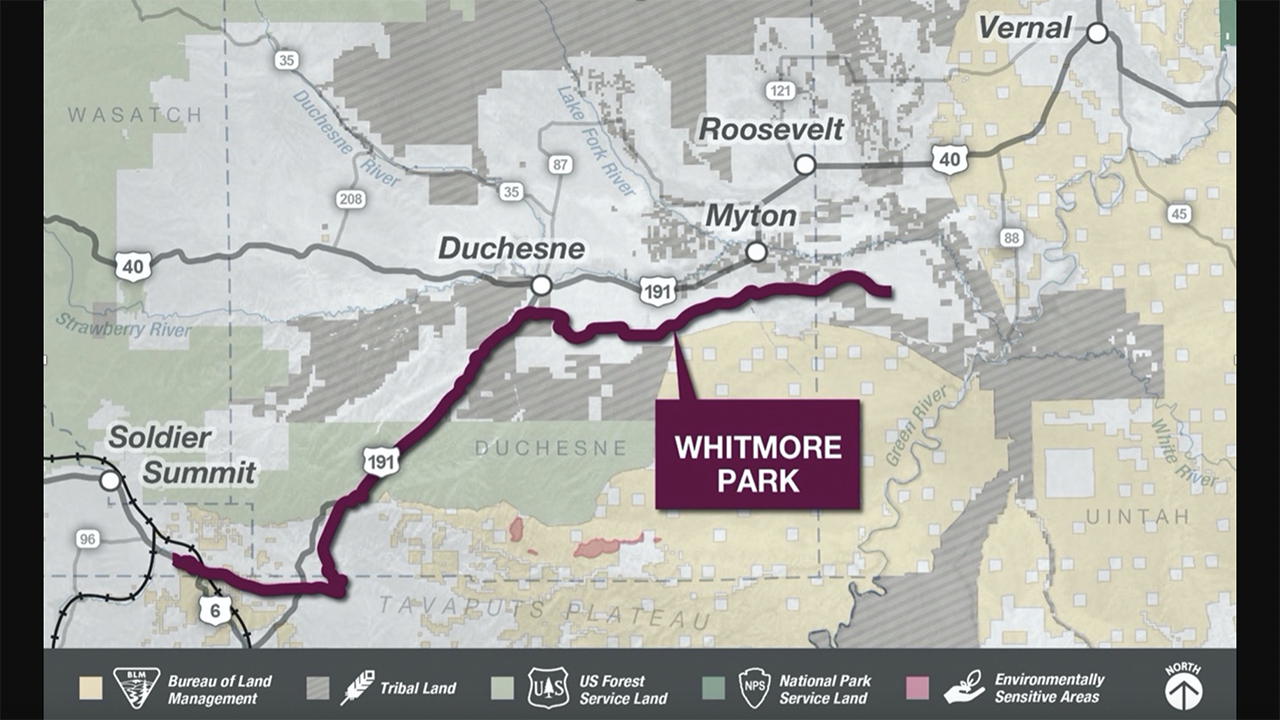
Will SCOTUS Review Uinta Basin Railway Case?
Written by Marybeth Luczak, Executive Editor
In August 2021, the STB Office of Environmental Analysis issued a Final EIS for the project, identifying the 88-mile Whitmore Park Alternative as the environmentally preferred route for the Uinta Basin Railway, one of three analyzed. It would extend from two terminus points in northeastern Utah’s Uinta Basin near Myton and Leland Bench to a connection with the existing Union Pacific Provo Subdivision near Kyune (see map above).
Utah’s Seven County Infrastructure Coalition has petitioned the U.S. Supreme Court to review a lower court’s decision that “derailed” the Uinta Basin Railway project, according to Colorado Newsline.
The Surface Transportation Board’s (STB) December 2021 approval of construction and operation of the Uinta Basin Railway was struck down last August by the U.S. Court of Appeals for the District of Columbia Circuit, which called it “arbitrary and capricious.”
The 88-mile line would be the first major freight railroad built in the U.S. in the past 30 years. Behind the project is Seven County Infrastructure Coalition, an “independent political subdivision” of the state of Utah that sought STB approval for the line, which would primarily haul shale-extracted crude oil. The Coalition joined forces with Drexel Hamilton Infrastructure Partners to raise private capital for the build and with Rio Grande Pacific Corporation to operate and maintain the line once completed. AECOM was chosen to lead the design, and the Skanska-Clyde Joint Venture and Obayashi Corporation would help with construction.
The court’s Aug. 18, 2023, decision granted in part the consolidated petitions of line opponents Eagle County, Colo., and the Center for Biological Diversity, and vacated the STB’s final exemption order. It also vacated in part STB’s Environmental Impact Statement outlining the various impacts associated with the railway’s construction and operation, and the Biological Opinion concerning the railway’s potential impacts on endangered species and critical habitats. The matter was remanded to STB for further proceedings.
The U.S. Court of Appeals for the District of Columbia Circuit late last year denied a petition to rehear challenges to its August decision, and the U.S. Forest Service in January withdrew its approval of a right-of-way permit that would have allowed construction of the railroad through about 12 miles of roadless, protected forest in Utah.
In a March 4, 2024, U.S. Supreme Court filing, the Seven County Infrastructure Coalition “claims the D.C. appeals court decision took too broad a view of the National Environmental Policy Act review required of the rail project, and that the federal regulatory agencies did not have to consider the impacts to Colorado or the Gulf Coast communities where the oil would be refined,” according to Colorado Newsline.
The media outlet explained that “[a]t stake is whether federal regulatory agencies must consider downstream impacts such as potential oil spills, wildfires and carbon emissions contributing to global warming. The coalition cites a 2004 case, Department of Transportation v. Public Citizen, which found an agency’s limited authority might not require it to consider more far-reaching impacts under NEPA.”
The coalition argued in the petition that “[b]oundless NEPA review hurts project proponents and the public too,” Colorado Newsline reported. “The time and expense of environmental review is a barrier to all kinds of new projects — including clean energy projects — that prevents some of them from ever getting off the ground. In the end, the only way to stop runaway scoping from overwhelming the NEPA process is to consistently apply this Court’s holding in Public Citizen.”
According to Colorado Newsline, appellate courts have interpreted the Public Citizen decision differently.
Wendy Park, a senior attorney for the Center for Biological Diversity, which along with Eagle County, Colo., were the “prime litigants suing to stop the rail project,” told Colorado Newsline that the appeal to the U.S. Supreme Court “is a last-ditch attempt to dodge environmental laws to facilitate a climate train wreck.” She said the “courts have made crystal clear that plans for this proposed oil train violate numerous federal laws. It’s unfortunate that Uinta Basin Railway backers are wasting more taxpayer money by taking the case to the Supreme Court. It’s time for this catastrophic oil-industry project to die once and for all.”
Meanwhile, Colorado Newsline reported, “Utah’s oil industry has been working on loadout facility expansion projects that would allow for a big increase in trucking traffic in the area and increase export capacity nearly to the level the rail project would have been able to accommodate, with significant negative air-quality impacts.” The media outlet added that “Democratic members of Colorado’s congressional delegation, led by U.S. Sens. Michael Bennet and John Hickenlooper, remain opposed to the Utah oil expansion increasing train traffic along the endangered Colorado River, while Utah Sen. Mike Lee and U.S. Rep. John Curtis of Provo have been trying — unsuccessfully so far — to reinstate approval of the rail project in amendments to various appropriations bills.”



